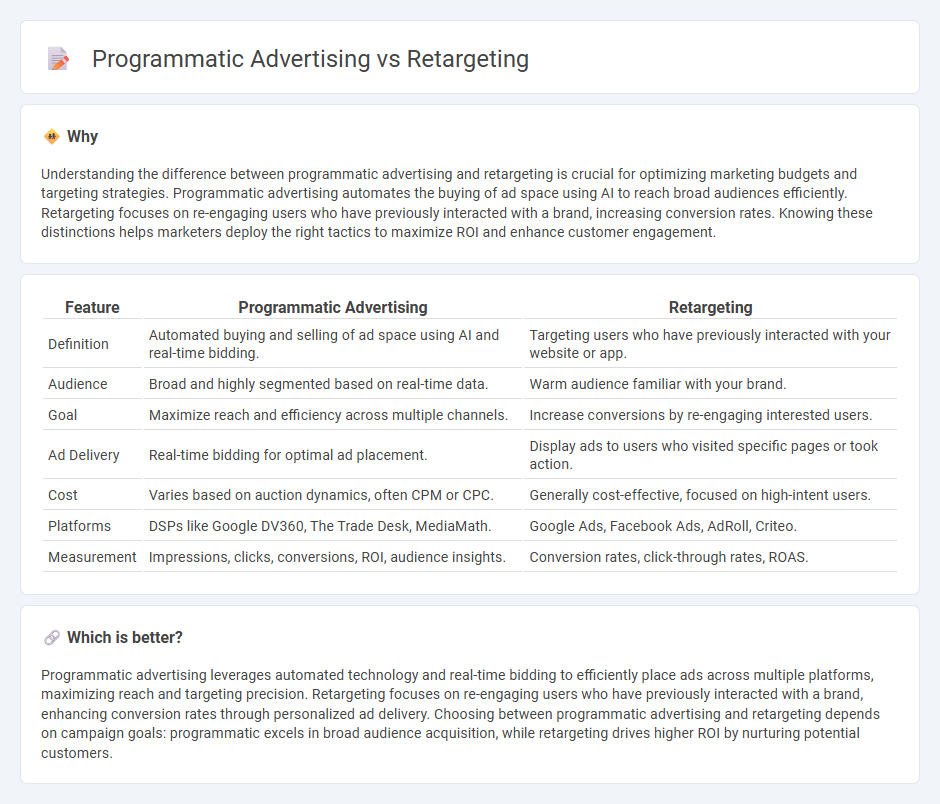
Programmatic advertising automates the buying of digital ad space using AI to target specific audiences in real-time, enhancing campaign efficiency and reach. Retargeting focuses on reconnecting with users who have previously interacted with a brand, increasing conversion potential through personalized ads. Explore the detailed strategies and benefits to optimize your marketing efforts effectively.
Why it is important
Understanding the difference between programmatic advertising and retargeting is crucial for optimizing marketing budgets and targeting strategies. Programmatic advertising automates the buying of ad space using AI to reach broad audiences efficiently. Retargeting focuses on re-engaging users who have previously interacted with a brand, increasing conversion rates. Knowing these distinctions helps marketers deploy the right tactics to maximize ROI and enhance customer engagement.
Comparison Table
| Feature | Programmatic Advertising | Retargeting |
|---|---|---|
| Definition | Automated buying and selling of ad space using AI and real-time bidding. | Targeting users who have previously interacted with your website or app. |
| Audience | Broad and highly segmented based on real-time data. | Warm audience familiar with your brand. |
| Goal | Maximize reach and efficiency across multiple channels. | Increase conversions by re-engaging interested users. |
| Ad Delivery | Real-time bidding for optimal ad placement. | Display ads to users who visited specific pages or took action. |
| Cost | Varies based on auction dynamics, often CPM or CPC. | Generally cost-effective, focused on high-intent users. |
| Platforms | DSPs like Google DV360, The Trade Desk, MediaMath. | Google Ads, Facebook Ads, AdRoll, Criteo. |
| Measurement | Impressions, clicks, conversions, ROI, audience insights. | Conversion rates, click-through rates, ROAS. |
Which is better?
Programmatic advertising leverages automated technology and real-time bidding to efficiently place ads across multiple platforms, maximizing reach and targeting precision. Retargeting focuses on re-engaging users who have previously interacted with a brand, enhancing conversion rates through personalized ad delivery. Choosing between programmatic advertising and retargeting depends on campaign goals: programmatic excels in broad audience acquisition, while retargeting drives higher ROI by nurturing potential customers.
Connection
Programmatic advertising leverages automated technology to purchase ad space, enabling precise targeting based on user data and behavior patterns. Retargeting specifically uses this data to display personalized ads to users who have previously interacted with a brand, enhancing conversion prospects. The integration of both strategies increases ad efficiency by delivering relevant content to high-intent audiences in real-time.
Key Terms
Audience Segmentation
Retargeting targets users who have already interacted with a brand, utilizing precise audience segmentation based on past behavior to increase conversion rates. Programmatic advertising employs automated technology to purchase ad space in real time, optimizing audience segments through advanced algorithms and data analysis across multiple platforms. Explore the differences in audience segmentation strategies to enhance your digital marketing effectiveness.
Real-Time Bidding
Retargeting leverages user data to deliver personalized ads to previous site visitors, enhancing conversion rates through targeted messaging. Programmatic advertising automates the buying process using Real-Time Bidding (RTB), allowing advertisers to bid on ad impressions in milliseconds for optimal audience reach and budget efficiency. Explore the detailed differences and strategic benefits of Real-Time Bidding in digital marketing through our in-depth guide.
Ad Personalization
Retargeting leverages user behavior data to deliver personalized ads to individuals who have previously interacted with a brand, enhancing conversion rates by targeting warm leads. Programmatic advertising automates the buying process using real-time bidding and AI algorithms to optimize audience targeting and ad placements across multiple channels efficiently. Explore the nuances of ad personalization in these strategies to maximize marketing ROI and engagement.
Source and External Links
Retargeting: Definition, Types and How-tos - Retargeting is a digital marketing tactic that serves tailored ads to users based on their prior engagement with a brand, typically to re-engage visitors who left a website without purchasing by using cookies and retargeting pixels embedded in the site.
What Is Retargeting? How To Set Up an Ad ... - Retargeting reconnects marketers with people who showed interest but didn't convert by dropping a JavaScript pixel on their browser which triggers tailored ads as they browse other sites, often increasing conversions with two main methods: pixel-based and list-based retargeting.
Retargeting | Digital Advertising Glossary - Retargeting helps convert the majority of site visitors who leave without purchasing by showing them ads for products they viewed, keeping those products top of mind while they browse other sites or apps to encourage them to return and buy.
 dowidth.com
dowidth.com